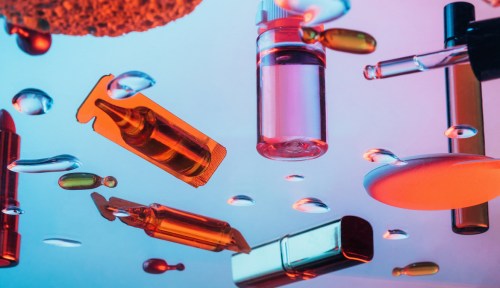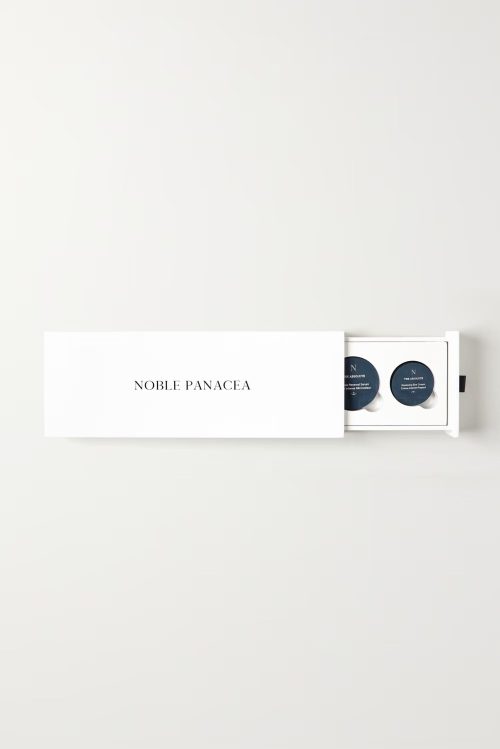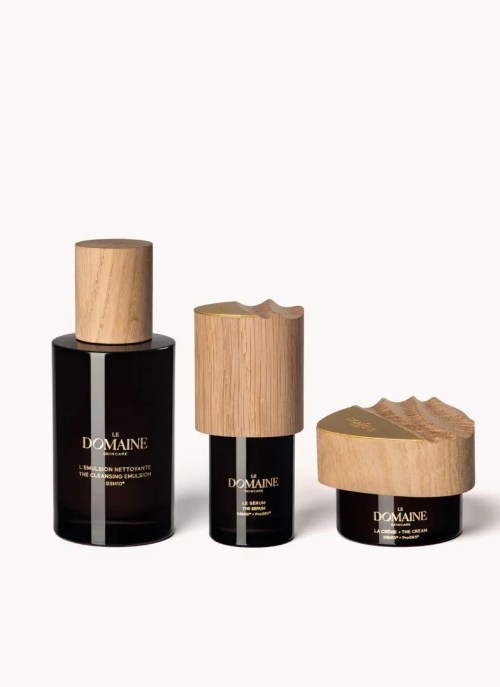Our editors independently select these products. Making a purchase through our links may earn Well+Good a commission
Medical Science and Genius-Level Technology Are Coming To Smarten Up Your Skin-Care Routine
Thanks to the merging of medical research, technology, and beauty, shelves are overstocked with the best skin-care science for 2024.

Rihanna. Lady Gaga. Jennifer Aniston. Selena Gomez. We have no shortage of beauty brands created by celebrities, but in equal measure, the number of genius-level talent leaving behind jobs at NASA and MIT and bringing their Nobel Prize-winning knowledge to techy, next-wave skin care is mounting. And this revolution doesn’t appear to be stopping any time soon, as new players enter the game to one-up devices, ingredients, and the way actives get into our skin and hair.
Experts in This Article
scientist and CTO of ELEMENT EIGHT Skincare
biomedical scientist, physician, and founder of the eponymous skin- and hair-care brand Augustinus Bader
founder of Matter of Fact Skincare
co-founder and CEO of K-18 Biomimetic Hairscience
While there can be arguments to be made that geniuses have always been behind the scenes, this trend of smarty-pants skin care kicked off in earnest in 2017 when Professor Augustinus Bader, one of the foremost experts in stem cell biology and regenerative medicine, applied what he’d learned treating burn patients to create his eponymous skin-care line, which quickly became a favorite in the world of luxury beauty. “As a medical doctor, I approached the creation of a skin-care product in a very different way,” he says. At the heart of the brand is a patented technology known as “TCF8” or “Trigger Factor Complex,” a blend of amino acids, vitamins, and compounds in all products.
“The complexity of translating medical technology into consumer skin care was situational. The hydrogel came from a situation where we had open skin wounds in a clinical setting,” he says. “It was complicated to change the approach for intact skin as it has to navigate the body’s natural healing code differently. After nearly two years of research and development, we found a unique solution, [TCF8], that provides a similar self-healing reaction.”
The line started with two creams—one medium-weight moisturizer and another rich moisturizer. Nearly five years later, the brand has expanded dramatically, not only selling a routine worth of skin-care products, hair-care products, and supplements. And the rest of the beauty world has been maneuvering to bring their equally genius brand founders to the forefront.
Here are the ones to know about in skin and hair care.
The Brands Revolutionizing Skin-Care Delivery Systems
Noble Panacea

Noble Panacea, The Absolute Discovery Ritual — $309.00
Noble Panacea, founded by Nobel-Prize-winning scientist Sir Fraser Stoddart, hinges on a technology called Organic Super Molecular Vessel that is 10,000 times smaller than a skin cell. Its itty-bitty size allows ingredients like vitamin C and retinol to not only enter the complexion on application, but to also be distributed throughout the day via an extend-release mechanism. “As OSMVs travel through the skin once they are applied, each vessel is programmed to deliver an ingredient for absorption at the optimal moment with control over the course of the day or through the night,” Anne Chapas, MD, a dermatological advisor to Noble Panacea previously told Well+Good.
Matter of Fact

Matter of Fact, Brigthening + Firming Serum — $92.00
Harvard > K-pop star > Beauty genius. That’s the progression of Paul Baek, the founder and scientist behind Matter of Fact. At the heart of the brand’s technology is a patented delivery system called Actisolve, “which utilizes unconventional delivery systems to deliver research-backed actives to skin in ways that maximize efficacy and usability while minimizing irritation.”
This delivery system allows the brand to couple potent ingredients that usually aren’t stable with one another into a single product, for example, L-ascorbic acid (vitamin C) and retinol. It also has enabled a 20 percent L-ascorbic acid to be dissolved in a waterless delivery mechanism, which isn’t usually possible for concentrations over 12 percent, which coincidentally can also break it down, according to the brand.
“Pure vitamin C is also well known to be fragile and breaks down in the presence of light, air, and especially water,” Baek says. “Because these two things are at odds [(needing water to dissolve vitamin C and that water breaking it down)], the challenge was to find a way to dissolve high concentrations of vitamin C without the use of water to increase the stability and shelf-life, while maintaining efficacy and cosmetic elegance.”
The results of the brand’s delivery system were published in the Journal of Investigative Dermatology, a peer-reviewed medical journal showing “undiminished clinical efficacy” of vitamin C at the beginning and near the end of the shelf life.
The Skin Care Bringing Medical-Grade Tech To Consumer Products
Pavīse

Pavīse, Functional Reset — $244.00
At the ripe age of 14, Sophie Bai was in the laboratory testing hypotheses about arthritis and anti-inflammatory herbal tea, and three years later, she came in first at an international engineering fair. The winning prize? A NASA star was named after her, and she got a full ride to MIT. Today, she runs B.A.I. Biosciences, one of the rising number of biotech firms carving out space in beauty. Since its inception, the brand has patented 20 proprietary molecules. Many of those technologies are present in Pavīse, a skin-care line from Bai and her team.
One of the most impressive technologies is called, “DiamondCore Shield,” present in the brand’s SPF, which filters out the UVA rays that cause skin aging.
is meant to filter out most UVA rays—those that cause the skin to age. Along with the line (which includes the aforementioned sunscreen as well as a lip SPF and an amino acid cleanser), the brand also offers a UV camera that shows photodamage you can’t see with the naked eye will help you understand where you might not be applying your SPF properly.
What’s afoot: B.A.I. is working to create brand-new UV filters that the brand purports can achieve an unheard-of SPF 1000 in the coming years. Sci-fi? Nah, just the future of the beauty industry as we know it.
Element Eight

Element Eight, 8 Day Transformation, Firm and Repair — $90.00
If you’re looking to find a dream team, you must accept no applications. The scientists behind Element Eight are spine surgeons, biomaterial engineers, dermatologists, clinical researchers, and systems group engineers. Together, they hold 16 MDs, PhDs, and 120 medical patents, and have created more than 100,000 technologies.
At the heart of their line is a proprietary OATH technology, initially developed for spin surgery, now used in skin care. Its purpose is delivering topical oxygen to the skin as deep as 700 microns, which is significant given that the dermis is usually between 50 to 150 microns deep, followed by the dermis, which is about 1,000 to 2,000 microns or one to two millimeters deep. “Oxygen is that essential element which cells require to stay alive,” says Andy Carter, scientist and CTO of ELEMENT EIGHT. By delivering it to the skin, we’re able to support the biological function of the skin and deliver performance for any cosmetics formulation.”
The brand pairs buzzy skin-care ingredients—hyaluronic acid, niacinamide, caffeine, and peptides—with oxygen, and it bundles the products into three different 8-Day Transformation Kits (which include eight days worth of doses) so that you can see how they work for you before investing in the full-sized versions. The results from clinical have been impressive, with many users indicating that in a week and a day, they’ve seen results.
Le Domaine

Le Domaine, The Complete Routine — $535.00
“Yes, we’re building Le Domaine with Brad Pit. No, we’re not another celebrity beauty brand,” reads the site. The brand was, yes, the brainchild of Brad Pitt and Marc Perrin, a Rhône Winemaker, but the pair teamed up with scientists to keep cutting-edge technology tapping into natural resources at the heart of their line.
First, a compound known as GSM10 has antioxidant properties to help reduce the breakdown of collagen and elastin in the skin. It was developed in conjunction with Professor Pierre-Louis Teissedre of the University of Bordeaux to transform Grenache grapes, typically used in winemaking, into a skin-care active meant to safeguard skin from the breakdown that tends to happen as skin ages.
GSM10 is coupled with PROGR3, an active that is the result of Dr. Nicolas Lévy and Professeur Pierre Cau’s work on a genetic disease called progeria, which causes children to age rapidly. In this cosmetic use, the pair of scientists has created an ingredient that has been shown to slow down the causes of aging. At present, the line consists of a tight edit of four products: a cleanser, cream, lightweight cream, and serum—but we suspect there will be more to come.
The Devices Bringing Derm-Office Results Home
Droplette

Droplette, Wrinkle Repair Set — $279.00
The Droplette is the brainchild of two (female!) engineers, medical diagnostics developer Rathi Srinivas and therapeutics designer Madhavi Gavini, who bought parts on eBay to build their prototype and were given their first-ever funding through a NASA grant. Droplette is a transdermal delivery tool, and works by transforming skin-care ingredients into a fine mist so that they can be delivered up to twenty times more deeply than other topical skin-care ingredients.
To date, you can shop for ingredients like retinol, tranexamic acid, glycolic acid, and growth factor; however, the most impressive feat is that the device allows you to mist in collagen—you know, the very stuff that makes your skin look plump and youthful?—to skin. The molecule is usually too large to penetrate the skin, meaning that with this new technology, new doors are being opened on ingredients we may have previously written off.
Lyma Laser

Lyma, The Lyma Laser Starter Kit — $2,695.00
Lyma founder Lucy Goff was ill and looking for a last resort when she met the man who is now the brand’s director of science, Paul Clayton, PhD, an Oxford-trained pharmacologist. He was responsible for helping her create a supplement regimen that she credits with helping turn around her health, which eventually nudged her to start the Lyma line.
Today, the brand comprises supplements, skin care, and a $2700 at-home laser that those in the know can’t stop clamoring about. The technology works on the intrinsic and extrinsic signs of aging, AKA those that happen because of biological processes and those that happen because of lifestyle factors. It reaches deeply—it claims to surpass the epidermis, dermis, and into the fat and muscle layers—to instruct cells to regenerate and repair while also signaling skin to create proteins to stop free-radical-induced damage.
Other lasers tend to function by the mechanism of wound repair, meaning that they injure the skin to signal your body’s natural processes to produce more collagen and elastin. This 808 nm laser is different, operating more like an LED light or simple-to-use at-home device that requires no downtime while offering serious results you’ll see within weeks of using it.
The Hair Care That’s Actually Reinventing Hair Care
K-18

K-18, Leave-In Molecular Repair Hair Mask — $75.00
“The K-18 peptide is a synthetic peptide that mimics hair’s inner structure to reverse chemical damage,” says Suveen Sahib, co-founder and CEO of K-18 Biomimetic Hairscience (which was recently acquired by Unilever). “It reconnects the broken polypeptide keratin chains and reforms cleaved disulfide bonds in damaged hair.”
Sahib says that his team began working on the K-18 technology around the time the human genome was decoded (nearly 20 years ago) and found that, “One of the protein fragments of globular proteins like Surfactant Protein D (SP-D) has a unique ability to diffuse through lipids—present in the innermost layers of our hair—and bind with lipophilic proteins such as keratin.”
From there, intense work on the proteins within hair led the brand to develop the juice at the heart of its formulas, which repair hair by addressing the chemical damage on the inside (rather than just getting the outside layer of hair to lay flatter so that it looks less damaged). “The result is a product that repairs your hair from the inside out and simplifies hair care routines by eliminating the need to use several products after you wash your hair,” says Sahib.
Sign up for the Well+Good SHOP Newsletter
Get exclusive deals on wellness, beauty, fitness, and food products that have been hand-picked by our editors.
Got it, you've been added to our email list.










